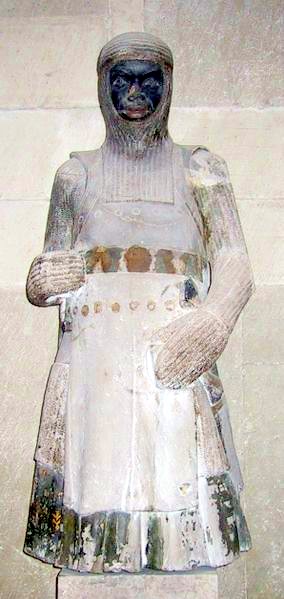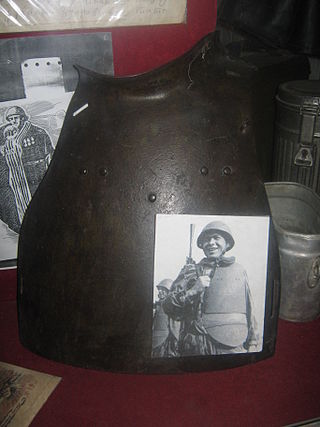
A breastplate or chestplate is a device worn over the torso to protect it from injury, as an item of religious significance, or as an item of status.

A breastplate or chestplate is a device worn over the torso to protect it from injury, as an item of religious significance, or as an item of status.
In medieval weaponry, the breastplate is the front portion of plate armour covering the torso. It has been a military mainstay since ancient times and was usually made of leather, bronze or iron in antiquity. By around 1000 AD, solid plates had fallen out of use in Europe and knights of the period were wearing mail in the form of a hauberk over a padded tunic. [1] Plates protecting the torso reappeared in the 1220s as plates directly attached to a knightly garment known as the surcoat. [2] [1] Around 1250 this developed into the coat of plates which continued to be in use for about a century. [3] [1] True breastplates reappear in Europe in 1340 first composed of wrought iron and later of steel. These early breastplates were made of several plates and only covered the upper torso with the lower torso not being protected by plate until the development of the fauld around 1370. [4] [2] [5] They were between 1–2.5 mm (0.039–0.098 in) in thickness. [5] In order to prevent the wearer from being cut by their own armour, the design featured outward turned edges that also increased stiffness. [5] In some cases, further strength was added by a ridge running down through the centre of the plate. [5] The first evidence for one-piece breastplates is from an altarpiece in the Pistoia cathedral dated to 1365. [4] Complete, lightweight, one or two-piece breastplates were readily used by the first decade of the 15th century. [4] [6] The French term pancier, which became English pauncher and German panzer , was also used.
Bullet-proof vests are the modern descendant of the breastplate.
Both Zeus and Athena are sometimes depicted as wearing a goatskin shield or breastplate called an Aegis. At the center of Athena’s shield was the head of Medusa.
The 14th century Majapahit Empire manufactured breastplate, called karambalangan . The most notable people using this type of breastplate is Gajah Mada, which is reported by Sundanese patih as wearing golden embossed karambalangan, armed with gold-layered spear, and with a shield full of diamond decoration. [7] [8] In Kidung Sunda canto 2 stanza 85 it is explained that the mantris (ministers or officers) of Gajah Mada wore armor in the form of chain mail or breastplate with gold decoration and dressed in yellow attire. [9] : 103
According to the biblical Book of Exodus, a "breastplate" or "breastpiece" was among the clothes of the Jewish High Priest. It was a folded-over cloth garment embedded with 12 different gemstones, each inscribed with the name of a tribe of Israel. [10]
In both the Hebrew Bible and the New Testament, the word 'breastplate' is used figuratively to describe protecting oneself from unrighteousness. [11]


The hair-pipe breastplates of 19th-century Interior Plains people were made from the West Indian conch, brought to New York docks as ballast and then traded to Native Americans of the upper Missouri River. Their popularity spread rapidly after their invention by the Comanche in 1854. They were too fragile and expensive to be considered armour, and were instead a symbol of wealth during the economic depression among Plains Indians after the buffalo were almost exterminated. [12]

This is a silicone or similar type of plastic vest or torso-plate that is placed over the male performer's chest, to mimic a woman's breast or cleavage. They are usually in a colour that matches the performer's own skin or to match an associated costume. [13]

The lorica segmentata, also called lorica lamminata, or banded armour is a type of personal armour that was used by soldiers of the Roman army, consisting of metal strips fashioned into circular bands, fastened to internal leather straps.

A cuirass is a piece of armour that covers the torso, formed of one or more pieces of metal or other rigid material. The word probably originates from the original material, leather, from the French cuirace and Latin word coriacea. The use of the term "cuirass" generally refers to both the breastplate and the backplate pieces; whereas a breastplate only protects the front, a cuirass protects both the front and the back of the wearer.

Plate armour is a historical type of personal body armour made from bronze, iron, or steel plates, culminating in the iconic suit of armour entirely encasing the wearer. Full plate steel armour developed in Europe during the Late Middle Ages, especially in the context of the Hundred Years' War, from the coat of plates(popular in late 13th and early 14th century) worn over mail suits during the 14th century.

Cuirassiers were cavalry equipped with a cuirass, sword, and pistols. Cuirassiers first appeared in mid-to-late 16th century Europe as a result of armoured cavalry, such as men-at-arms and demi-lancers discarding their lances and adopting pistols as their primary weapon. In the later part of the 17th century, the cuirassier lost his limb armour and subsequently wore only the cuirass, and sometimes a helmet. By this time, the sword or sabre had become his primary weapon, with pistols relegated to a secondary function.
Gajah Mada, also known as Jirnnodhara, was a powerful military leader and mahapatih of the Javanese empire of Majapahit during the 14th century. He is credited in Old Javanese manuscripts, poems, and inscriptions with bringing the empire to its peak of glory.

A brigandine is a form of body armour from the Middle Ages. It is a garment typically made of heavy cloth, canvas, or leather, lined internally with small oblong steel plates riveted to the fabric, sometimes with a second layer of fabric on the inside.

Chausses were a Medieval term for leggings, which was also used for leg armour; routinely made of mail and referred to as mail chausses. They generally extended well-above the knee, covering most of the leg. Mail chausses were the standard type of metal leg armour in Europe from the 11th to the 14th century. Chausses offered flexible protection that was effective against slashing weapons. However, the wearer still felt the full force of crushing blows.

The poleyn or genouillere was a component of Medieval and Renaissance armor that protected the knee. During the transition from mail armor to plate armor, this was among the earliest plate components to develop. They first appeared around 1230 and remained in use until 1650 when firearms made them obsolete.

The European buff coat is an item of leather clothing that was primarily worn by cavalry and officers during the 17th century, but also worn by a small number of infantry. It was often worn under iron or steel armour for the torso. The buff coat was derived from the simple leather jerkins employed by huntsmen and soldiers during the Tudor period, these in turn deriving from the arming doublet. The name of the jacket, as well as its characteristic tan or buff colour, derives from the buffalo or ox hide from which it was commonly made.

A coat of plates is a form of segmented torso armour consisting of overlapping metal plates riveted inside a cloth or leather garment. The coat of plates is considered part of the era of transitional armour and was normally worn as part of a full knightly harness. The coat saw its introduction in Europe among the warring elite in the 1180s or 1220s and was well established by the 1250s. It was in very common usage by the 1290s. By the 1350s it was universal among infantry militias as well. After about 1340, the plates covering the chest were combined to form an early breastplate, replacing the coat of plates. After 1370, the breastplate covered the entire torso. Different forms of the coat of plates, known as the brigandine and jack of plates, remained in use until the late 16th century.

The Dendra panoply or Dendra armour is an example of Mycenaean-era panoply made of bronze plates uncovered in the village of Dendra in the Argolid, Greece.

Scholars agree that Japanese armour first appeared in the 4th century, with the discovery of the cuirass and basic helmets in graves. During the Heian period (794-1185), the unique Japanese samurai armour ō-yoroi and dō-maru appeared. The Japanese cuirass evolved into the more familiar style of body armour worn by the samurai known as the dou or dō, with the use of leather straps (nerigawa), and lacquer for weatherproofing. Leather and/or iron scales were also used to construct samurai armours, with leather and eventually silk lace used to connect the individual scales (kozane) of these cuirasses.

A plackart is a piece of medieval and Renaissance era armour, initially covering the lower half of the front torso. It was a plate reinforcement that composed the bottom part of the front of a medieval breastplate. They were predominantly worn in the 15th century. Sometimes they were worn with a metal finish, while the top part of the cuirass was covered in material, the difference in finish making a contrast.
The Battle of Bubat also known as Pasunda Bubat is the battle between the Sundanese royal family and the Majapahit army that took place in Bubat Square on the northern part of Trowulan in 1279 Saka or 1357 CE.

Dō or dou (胴) "breastplate, cuirass" is one of the major components of Japanese armour worn by the samurai and ashigaru or foot soldiers of feudal Japan.

Steel breastplate, or Stalnoi Nagrudnik is a type of body armor similar to a cuirass developed by the Red Army in World War II. The native Cyrillic abbreviation for the vest was "СН", the Cyrillic letters Es and En. It consisted of two pressed steel plates that protected the front torso and groin. The plates were 2 mm (0.079 in) and weighed 3.5 kg (7.7 lb). This armor was supplied to SHISBr.

Armour in the 18th century was minimalist and restricted almost entirely to cavalry, primarily to cuirassiers and, to a lesser degree, carabiniers and dragoons. Armour had been in rapid decline since the Thirty Years' War, although some archaisms had lingered on into the early years of the 18th century, like Austrian cuirassiers with buff coats and lobster-tailed helmets or Hungarian warriors with mail armour and shields. With the exception of Poland-Lithuania, which still made use of hussars wearing suits of plate armour, armour in Europe was primarily restricted to a breast- and backplate, the cuirass, and a simple iron skull cap worn under the hat. By the later 18th century, there were two contradicting developments. Many cuirassier regiments were discarding their cuirasses, while helmets in the form of so-called dragoon helmets, made of brass or leather, made a comeback among the cavalry and infantry.

Karambalangan is a type of personal armor from Java. It is a metal coating worn in front of the chest or breastplate.

Kawaca is a term for war attire mentioned in Old Javanese texts. Its name comes from the Sanskrit kawaca which means armor, cuirass, a type of chain mail, any kind of cover, corset, jacket.

Siping-siping, simping-simping, or sisimping, is a type of armor used in Java. It is a short sleeveless jacket made of scale-shaped metal plates.